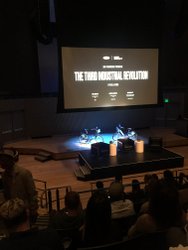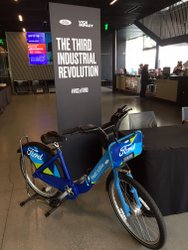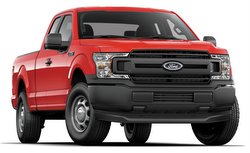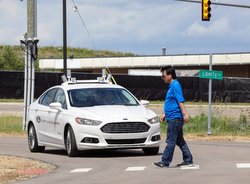A Conversation with Brett Hinds, Ford’s Chief Engineer for Electrified Powertrain Systems
Today, cars with full or partial battery power are not big sellers, so companies must balance short-term profit with long-term planning for what is increasingly seen as the future of transportation. Ford wants to be recognized as a future-looking company, so they have 13 hybrids and full-electric cars scheduled for release between now and 2020. They are also developing on-demand mobility options through subsidiaries like Chariot and the Go Bike bicycle-sharing program.

Beyond vehicles and its own programs, Ford supports programs to show their involvement in the new mobility space. One such event is sponsorship of a screening of The Third Industrial Revolution, a new film produced by VICE Impact that features social and economic theorist Jeremy Rifkin’s road map to a more sustainable world. Ford’s shared mission with VICE Impact is “to connect today’s innovative thinkers to the future of mobility and inspire new advancements and collaborations for meaningful impact.”

The thought-provoking hour-and-44-minute film is a recorded presentation of Rifkin talking with a group of young people about the topics in his 2011 book of the same name. It’s a call to action in the same spirit as Al Gore’s An Inconvenient Truth, and makes its case for a two-generation-long effort to replace the carbon-based Second Industrial Revolution economy of the last century with a new sustainable one. The film will be released later this year in wider circulation.
As part of this presentation, Brett Hinds, Ford’s chief engineer for electrified powertrain systems, was in attendance, and kindly sat down with me to talk about what Ford is planning for an electrified future.
13 New Electrified Vehicles by 2020
Hinds described seven of the upcoming 13 new vehicles that Ford has announced so far. We’ll be seeing two new police vehicles, a plug-in Transit Custom in Europe, and an autonomous hybrid, but the most significant ones to me are hybrid versions of the Mustang and the F-150 pickup and a pure electric crossover SUV with a 300-mile range.
“With the F-150 and Mustang, we’ll make electrification enhance the performance,” said Hinds. “The F-150 is a work vehicle, so electrification will enhance the towing experience, while at the same time improving fuel economy and reducing C02.”

What happens to the Mustang, a sports car, when you add electricity? Per Hinds, the added motor and battery will help provide more spirited, high-performance driving, while, like the electrified F-150, offer better fuel economy and lower CO2 emissions.
“The Mustang a very emotional vehicle,” said Hinds. “People like the rumble, the exhaust sound. So, the motor will assist performance–along with the engine.”
A 300-mile Range Electric SUV
A 300-mile all-electric model sounds like a direct competitor for the Chevrolet Bolt, Tesla Model 3 and upcoming Nissan leaf. Ford has high hopes for success in this small, but growing segment.
“By introducing a 300-mile-range full-electric as an SUV–the fasted-growing segment now in the market–we will be a class leader with a class-leading range,” Hinds said.
The remaining six cars are still secret, but Hinds was clear in saying that they are partnering with others to leave their options open, depending on what happens over the short and long term. For example, they have worked with Volkswagen and Mercedes-Benz on a fast-charging network in Europe and collaborated with cities and other companies in the industry to build infrastructure.

“That’s the better way to go,” said Hinds. “You get the technology faster, and when new technology is available, we can adapt; we’re not locked into a factory.”
Hinds assured me that a Ford will still feel like a Ford when you drive it, regardless of its powertrain.
“We design our own control systems in-house,” said Hinds. “Control systems are the logic–the brains running the car–its nervous system. So, when you get into an electrified Fiesta, Focus, or F-150, it will feel like a Ford in the way it drives and responds. “
In-house Design vs. Partnerships
Regardless of the usefulness of partnerships, Ford has a lot of say in the way its electric powertrains work.
“We have capability in-house to design batteries and battery packs, and then we can work strategically with partners to build them,” said Hinds. “We’re not just buying off-the-shelf.”

I asked Hinds about how he sees the future now. He predicted that by 2030, the global market would be divided roughly into thirds, with one third plug-in or battery electric vehicles, another third hybrids, and the last third traditional gasoline or diesel. I asked him about why there would still be a call for carbon-based models then.
“An F-450 truck, for example, is built for working hard, and a battery version isn’t going to be ready yet,” he explained. “And for some entry-level vehicles, electrification is still premium-priced, so these vehicles will remain gasoline-powered unless there’s a massive shift in the geopolitical climate or battery technology.”
What about the farther future? Hinds sees three trends that could help meet the challenges:
- Cost: As technology matures, battery range and cost will go down, but it’s still a premium. However, it will be possible for customers to get a payback for going electric within the ownership span of the car.
- Scale: Increased volume will help lower pricing.
- Charging Infrastructure: Increased partnerships with other industries will help to build it.
Hinds is a longtime engineering veteran at Ford, driving leading edge engine technology over his long career. But he’s happy about the challenge of working on electric powertrains now.
“It’s part of something that’s bigger. We’re helping set the foundation for what will be the new powertrain for Ford in the next 10-20 years.”
Related Stories You Might Enjoy:
News: Police Go Green with Ford Fusion Hybrid
News: Ford eMobility Moves Take Company into New Territory
News: Ford F-150 Hybrid Confirmed
Ford’s Silicon Valley Lab leads the Way to New Mobility

4 thoughts on “Interview: Ford’s Electrified Future”